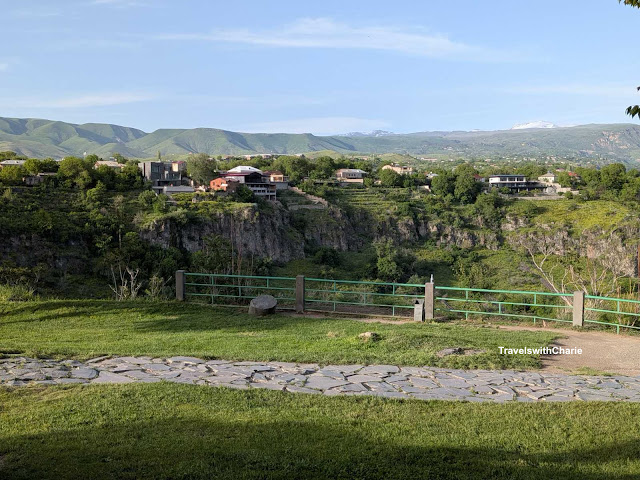The Garni Temple was built in the first century AD, during the reign of King Tiridates I of Armenia. It is believed to have been dedicated to the pagan god Mihr (Mithra), who is associated with fire. Other scholars suggest that Garni was built as a tomb or mausoleum. One of the theories advanced by some scholars is that a pagan temple could not have survived after Armenia became a Christian state in the fourth century AD.
The elegance of Garni Temple comes from the fusion of architectural styles and building materials of these three cultures, Hellenistic, Roman and Armenian. Twenty-four Ionic columns are inspired by classical Greek architecture. The structure incorporates arches and vaults which are of Roman origin. The temple is built with local basalt stone which was carved and fitted together without using mortar.
The second important element of this Temple is its location. It sits on a promontory above Garni Gorge with views of surrounding mountains. A symbiosis exists between nature and architecture resulting in an unparalleled setting. Lastly, there is peace and serenity in these mountains. I found myself sitting quietly, taking in the view of the natural landscape and marveling at how this ancient civilization got it right when they chose this location. (I do not know how long peace will prevail as more people discover this place).
This is the ruins of the royal palace. It measures about 40 meters long by 15 meters wide (132 ft x 49 ft.). It sits on the western side of the temple at the edge of the promontory overlooking the canyon and Gegham mountains.
In preserving the Temple, it was important to safeguard the aesthetics of the structure while ensuring it would be around for many generations to come. Traditional techniques, materials and anastylosis methodology were used to maintain its authenticity. When restoration efforts are true to the original form and a significant portion of the original materials are used in the rebuilding process, then the visitor experience should be the same as if he/she is viewing the original structure from the first century. While the individual components may not be entirely original, the essence and character of the original structure remains intact.
Ionic style columns support the structure. The ionic capitals are original except for two columns which were badly eroded. More than fifty percent of the column shafts had to be replaced. Many of the decorative elements on the frieze and architrave above the capitals are original and those that are not have been replaced with plain stone.
Mosaic tiles decorate the floor of the Roman bathouse.
Detail of mosaic tiles from the Roman bathouse.
This image shows the hypocaust system of heating the Roman bathouse in the Garni complex. This ancient system uses a raised floor supported by widely spaced pillars. The empty space below allows hot air from a furnace to circulate and heat the rooms.
Armenia submitted the Archaelogical Complex of Garni to the temporary list of UNESCO World Heritage Sites in March 2025. The Temple is about 19 miles east of Yerevan. There's a fee to enter the complex.
View of the canyon and town
How to get there from Tbilisi, Georgia
I traveled to Armenia with G7 Euro Travel and Tours. Please check out my post about Travel Tips and Resources here: https://www.travelswithcharie.com/p/travel-tips.html
Where to stay:
Holiday Inn Express is a ten-minute walk to Republic Square and beside Mashtots Park. It's on Buzand 97/2. It offers free breakfast. Reservations link is ihg.com.
Currency in Armenia : Dram. $1.00 is equivalent to 383.23 dram (exchange rate on June 14, 2025).
Electrical Outlet: Type C or F
Stay connected
*****
Images by TravelswithCharie








